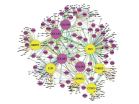Are there as many rats as people in New York City?
2014-11-04
(Press-News.org) Urban legend states that New York City has as many rats as people: roughly 8 million; but a new analysis suggests there are nowhere near as many.
The analysis classified rat sightings by city lot, of which there are roughly 842,000 in New York City. The researchers estimated 40,500 rat-inhabited lots in the city. By liberally assuming that 40 to 50 rats belong to a typical colony and that one full colony occupies each rat-inhabited lot, the researchers concluded that 2 million would be an extremely generous estimate of the city's rat population.
"While the rat population remains a serious problem in New York City, there appears to be no evidence supporting the 8 million number. In problems like this, the city's open data is invaluable for challenging rumors, evaluating community need and establishing government efficacy," said Jonathan Auerbach, author of the Significance study winner of the YSS/Significance Young Statisticians Writing Competition.
INFORMATION:
ELSE PRESS RELEASES FROM THIS DATE:
2014-11-04
PROVIDENCE, R.I. [Brown University] — Type 2 diabetes (T2D) and cardiovascular disease (CVD) appear to have a lot in common. They share risk factors such as obesity and they often occur together. If they also share the same genetic underpinings, then doctors could devise a way to treat them together too. With that hope in mind, scientists applied multiple layers of analysis to the genomics of more than 15,000 women. In a new study they report finding eight molecular pathways shared in both diseases as well as several "key driver" genes that appear to orchestrate the ...
2014-11-04
A global research effort has resolved a major biosecurity issue by determining that four of the world's most destructive agricultural pests are one and the same.
The Oriental fruit fly, the Philippine fruit fly, the Invasive fruit fly, the Carambola fruit fly, and the Asian Papaya fruit fly cause incalculable damage to horticultural industries and food security across Asia, Africa, the Pacific, and parts of South America. More than 40 researchers from 20 countries examined available evidence and determined that the Carambola fruit fly is a distinct species, but the other ...
2014-11-04
A new study found that 43% of nursing students indulge in hazardous alcohol consumption, with 14.9% of men and 18.7% of women meeting criteria for hazardous drinkers.
Hazardous drinkers were more likely to be young, to smoke, and to live outside the family nucleus.
"Alcohol-prevention activities should envisage greater protection of university settings, particularly where future health professionals are involved," wrote the authors of the Journal of Advanced Nursing study.
INFORMATION:
...
2014-11-04
New research indicates that scent associated with polar bear paws conveys information that may affect the animals' social and reproductive behavior. This chemical form of communication was likely shaped by the environmental constraints of Arctic sea ice.
Scientists worry that this communication may be impacted if scent trails are disrupted due to increased fracturing of sea ice from climate change.
"Effective communication is essential for successful reproduction in solitary, wide-ranging animals," said Dr. Megan Owen, lead author of the Journal of Zoology study. "Developing ...
2014-11-04
A geologist in Syracuse University's College of Arts and Sciences has demonstrated that earthquakes--not climate change, as previously thought--affect the rate of landslides in Peru.
The finding is the subject of an article in Nature Geoscience (Nature Publishing Group, 2014) by Devin McPhillips, a research associate in the Department of Earth Sciences. He co-wrote the article with Paul Bierman, professor of geology at The University of Vermont; and Dylan Rood, a lecturer at Imperial College London (U.K.).
"Geologic records of landslide activity offer rare glimpses ...
2014-11-04
The current Ebola outbreak in West Africa has grown exponentially since May, indicating inadequate global response. A new analysis indicates that the outbreak's fatality rate is over 70%—rather than 50% as previously claimed by the World Health Organization—and that the total number of affected individuals could exceed 1 million by early next year.
As long as the number of infected people rises exponentially, the likelihood of exporting Ebola to other countries does as well.
"The disease itself hasn't changed, with essentially the same fatality rate and ...
2014-11-04
A new study of 63 women with varied infant feeding experiences reveals that breastfeeding mothers may feel shame if they breastfeed in public due to exposure, while those who do not breastfeed may experience shame through 'failing' to give their infant the 'best start.'
Breastfeeding and non-breastfeeding mothers may also experience shame through inadequate support, judgment, and condemnation, leading to feelings of failure, inadequacy, and isolation.
"This study highlights the difficulties and tensions that breastfeeding and non-breastfeeding women can face in hospital ...
2014-11-04
In people under age 30, radiation is a risk factor for a type of brain tumor called a meningioma, a Loyola University Medical Center study has found.
Researchers analyzed records of 35 patients who were diagnosed with meningiomas before age 30. Five had been exposed to ionizing radiation earlier in their lives. They include two patients who received radiation for leukemia at ages 5 and 6; one who received radiation at age 3 for a brain tumor known as a medulloblastoma; and one who received radiation for an earlier skull base tumor that appeared to be a meningioma. The ...
2014-11-04
New research indicates that bald and golden eagles in North America may be exposed to dangerously high levels of polybrominated diphenyl ethers (PBDEs), which are chemicals used in the production of a wide variety of textiles, plastics, and electronics.
Investigators analyzed the livers of 33 bald eagles and 7 golden eagles collected throughout Washington and Idaho, finding that eagles associated with large urban areas had the highest PBDE concentrations.
"The PBDE concentrations we observed in eagle livers suggest a range of exposure, from nearly no detection to concentrations ...
2014-11-04
New research is challenging the decades-old belief that smoking cigarettes helps keep you slim.
A BYU study published in the American Journal of Physiology: Endocrinology and Metabolism finds that exposure to cigarette smoke can actually cause weight gain. But here's the kicker: Secondhand smoke is the biggest culprit.
"For people who are in a home with a smoker, particularly children, the increased risk of cardiovascular or metabolic problems is massive," said author Benjamin Bikman, professor of physiology and developmental biology at Brigham Young University.
Data ...
LAST 30 PRESS RELEASES:
[Press-News.org] Are there as many rats as people in New York City?


